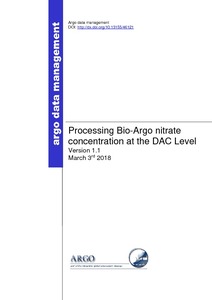| dc.contributor.author | Johnson, Ken | |
| dc.contributor.author | Pasqueron De Fommervaul, Orens | |
| dc.contributor.author | Serra, Romain | |
| dc.contributor.author | D'Ortenzio, Fabrizio | |
| dc.contributor.author | Schmechtig, Catherine | |
| dc.contributor.author | Claustre, Herve | |
| dc.contributor.author | Poteau, Antoine | |
| dc.date.accessioned | 2018-07-28T13:12:49Z | |
| dc.date.available | 2018-07-28T13:12:49Z | |
| dc.date.issued | 2018 | |
| dc.identifier.citation | Johnson, K.; Pasqueron De Fommervault, O.; Serr, R.; D'Ortenzio, F.; Schmechtig, C.; Claustre, H. and Poteau Antoine (2018) Processing Bio-Argo nitrate concentration at the DAC Level. Version 1.1, March 3rd 2018. IFREMER for Argo Data Management, 22pp. DOI: http://doi.org/10.13155/46121 | en_US |
| dc.identifier.uri | http://hdl.handle.net/11329/492 | |
| dc.identifier.uri | http://dx.doi.org/10.25607/OBP-74 | |
| dc.description.abstract | The only method used to date to measure dissolved nitrate concentration (NITRATE) with sensors mounted on profiling floats is based on the absorption of light at ultraviolet wavelengths by nitrate ion (Johnson and Coletti, 2002; Johnson et al., 2010; 2013; D’Ortenzio et al., 2012). Nitrate has a modest UV absorption band with a peak near 210 nm, which overlaps with the stronger absorption band of bromide, which has a peak near 200 nm. In addition, there is a much weaker absorption due to dissolved organic matter and light scattering by particles (Ogura and Hanya, 1966). The UV spectrum thus consists of three components, bromide, nitrate and a background due to organics and particles. The background also includes thermal effects on the instrument and slow drift. All of these latter effects (organics, particles, thermal effects and drift) tend to be smooth spectra that combine to form an absorption spectrum that is linear in wavelength over relatively short wavelength spans. If the light absorption spectrum is measured in the wavelength range around 217 to 240 nm (the exact range is a bit of a decision by the operator), then the nitrate concentration can be determined.
Two different instruments based on the same optical principles are in use for this purpose. The In Situ Ultraviolet Spectrophotometer (ISUS) built at MBARI or at Satlantic has been mounted inside the pressure hull of a Teledyne/Webb Research APEX and NKE Provor profiling floats and the optics penetrate through the upper end cap into the water. The Satlantic Submersible Ultraviolet Nitrate Analyzer (SUNA) is placed on the outside of APEX, Provor, and Navis profiling floats in its own pressure housing and is connected to the float through an underwater cable that provides power and communications. Power, communications between the float controller and the sensor, and data processing requirements are essentially the same for both ISUS and SUNA.
There are several possible algorithms that can be used for the deconvolution of nitrate concentration from the observed UV absorption spectrum (Johnson and Coletti, 2002; Arai et al., 2008; Sakamoto et al., 2009; Zielinski et al., 2011). In addition, the default algorithm that is available in Satlantic sensors is a proprietary approach, but this is not generally used on profiling floats. There are some tradeoffs in every approach. To date almost all nitrate sensors on profiling floats have used the Temperature Compensated Salinity Subtracted (TCSS) algorithm developed by Sakamoto et al. (2009), and this document focuses on that method.
It is likely that there will be further algorithm development and it is necessary that the data systems clearly identify the algorithm that is used. It is also desirable that the data system allow for recalculation of prior data sets using new algorithms. To accomplish this, the float must report not just the computed nitrate, but the observed light intensity.
Then, the rule to obtain only one NITRATE parameter is, if the spectrum is present then, the NITRATE should be recalculated from the spectrum while the computation of nitrate concentration can also generate useful diagnostics of data quality. | en_US |
| dc.language.iso | en | en_US |
| dc.publisher | IFREMER for Argo Data Management | en_US |
| dc.subject.other | Dissolved nitrate concentration | en_US |
| dc.title | Processing Bio-Argo nitrate concentration at the DAC Level. Version 1.1, March 3rd 2018. | en_US |
| dc.type | Report | en_US |
| dc.description.status | Published | en_US |
| dc.format.pages | 22pp. | en_US |
| dc.description.refereed | Refereed | en_US |
| dc.publisher.place | Villefranche-sur-Mer, France | en_US |
| dc.identifier.doi | 10.13155/46121 | |
| dc.subject.parameterDiscipline | Parameter Discipline::Chemical oceanography::Nutrients | en_US |
| dc.subject.dmProcesses | Data Management Practices::Data processing | en_US |
| dc.subject.dmProcesses | Data Management Practices::Data acquisition | en_US |
| dc.description.currentstatus | Current | en_US |
| dc.description.eov | Nutrients | en_US |
| dc.description.maturitylevel | TRL 8 Actual system completed and "mission qualified" through test and demonstration in an operational environment (ground or space) | en_US |
| dc.description.bptype | Standard Operating Procedure | en_US |
| dc.description.bptype | Manual | en_US |
| obps.resourceurl.publisher | http://www.argodatamgt.org/documentation/ | en_US |
 Repository of community practices in Ocean Research, Applications and Data/Information Management
Repository of community practices in Ocean Research, Applications and Data/Information Management
